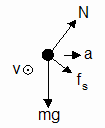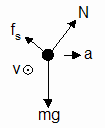![]() P123. Circular Motion and Apparent Weight
P123. Circular Motion and Apparent Weight
These problems are designed to lead you step-by-step through the process of solving a variety of circular motion problems. Provide answers as requested.
|

Suppose you're standing on a bathroom scale in Quito, Ecuador as shown to the right. Quito is on the equator.
-
Draw a dot to represent you.
-
Extending from the dot, draw and label the two forces acting on you. Use standard letter symbols such as T, mg or W, N, fk, and fs. Make your forces correspond to the orientation of the figure. For example, the weight force must point to the left (toward the center of the Earth).
-
Add an arrow somewhere on the diagram (but not to be confused with the forces) to represent the direction of your acceleration. Label it a. This will also be the direction of +x as is typical practice.
-
Add either a
 (out of screen) or a
(out of screen) or a  (into the screen) to represent the direction of your velocity. Label it v.
(into the screen) to represent the direction of your velocity. Label it v. -
Write the net force equation that applies to you.
-
The scale reading, which is the normal force, is your apparent weight; therefore, your apparent weight is less than your actual weight at the equator as a result of the Earth's rotation. With reference to the net force equation and the direction of the acceleration, explain in words why this is the case.
-
Solve the net force equation for N and divide by mg to show that N/mg = 1 - a/g.
-
Express the acceleration in terms of the radius R of the Earth and period T of the Earth's rotation in order to show the following:

-
Finally, substitute values of R, g, and T, and calculate the ratio N/mg to 3 significant figures. Expect a result just slightly less than 1. See the inside back cover of your text for the value of Re. We hope you know the value of the rotation period without looking it up, but be sure to convert to seconds. Use scientific notation.
-

An astronaut is in a low-Earth orbit at a distance of 160 km from the Earth's surface as shown to the right.
-
Draw a dot to represent the astronaut.
-
Extending from the dot, draw and label the only force acting on the astronaut.
-
Add and label an arrow to represent the direction of the astronaut's acceleration.
-
Add and label an arrow to represent the direction of the astronaut's velocity.
-
Write the net force equation that applies to the astronaut.
-
What is the ratio of the gravitational weight of the astronaut in orbit to the gravitational weight of the same astronaut when sitting on the launch pad on Earth?
-
One typically hears that an astronaut in orbit is weightless. How can that be, considering your calculation of part f.
-
-
 A person is in an amusement park ride consisting of a rotating drum of radius R as shown to the right. When the ride starts, the person is standing with his back to the wall and the floor in place to support him. At some point as the ride speeds up, the floor drops down, but the person doesn't. The following questions apply to the situation after the floor has dropped.
A person is in an amusement park ride consisting of a rotating drum of radius R as shown to the right. When the ride starts, the person is standing with his back to the wall and the floor in place to support him. At some point as the ride speeds up, the floor drops down, but the person doesn't. The following questions apply to the situation after the floor has dropped. -
As in the previous problems, draw a force diagram for the forces on the person and indicate the directions of velocity and acceleration.
-
The normal force of the wall on the person points to the center of the path, and is the force responsible for the person's circular motion. Which of the forces on your force diagram is the apparent weight?
-
Write the horizontal and vertical net force equations for the person in the rotating drum.
-
Solve the net force equations simultaneously together with fs ≤ μsN to find the minimum speed at which the drum must rotate in order that the person doesn't slide down. Give your answer in terms of μs, g, and the radius R of the person's circular path.
-
4.  The design speed of a banked curve is the speed at which a vehicle can round the curve without requiring any static friction force to keep it in a circular path. Carry out the same steps as in the previous problems for the car on the curve at design speed.
The design speed of a banked curve is the speed at which a vehicle can round the curve without requiring any static friction force to keep it in a circular path. Carry out the same steps as in the previous problems for the car on the curve at design speed.
-
Draw a force diagram for the forces on the person and indicate the directions of velocity and acceleration for the situation when the car is moving at its design speed.
-
Write the horizontal and vertical net force equations for the person when the car is moving at design speed.
-
The apparent weight of the person is the normal force on him. Determine an expression for the ratio of the normal force to the gravitational weight, N/mg, in terms of the angle θ that the roadbed makes with the horizontal.
-
Check your result in part c by examining the special cases of a horizontal and a vertical roadbed. What result does your equation predict in each case, and is the result consistent with the physical reality of the situation?
-
Suppose the car is going too fast to continue moving in a circular path without the force of static friction to help out. Which of the following force diagrams shows the correct direction of the static friction force necessary to keep the car from skidding to the outside of the curve? Explain your choice.
Figure 1 Figure 2
-
 A bucket of water is swung in a vertical circle of radius R as shown in the diagram to the right. Suppose that the magnitude of the bucket's velocity at the top of the circle is greater than the minimum value necessary for the water to stay in the bucket.
A bucket of water is swung in a vertical circle of radius R as shown in the diagram to the right. Suppose that the magnitude of the bucket's velocity at the top of the circle is greater than the minimum value necessary for the water to stay in the bucket. -
Proceed as in the previous problems to draw the diagram and write a net force equation.
-
The tension force is the apparent weight in this case. Solve the net force quation for the ratio T/mg in terms of a and g.
-
The tension force may or may not be greater than the weight force. The relative magnitude of the two forces depends on the velocity. For the case that T/mg = 0, what is the velocity of the bucket at the top of the circle in terms of R and g?
-
Suppose the velocity at the top of the circle is twice as great as the value determined in part c. Determine the numerical value of the ratio T/mg = 0.
-

